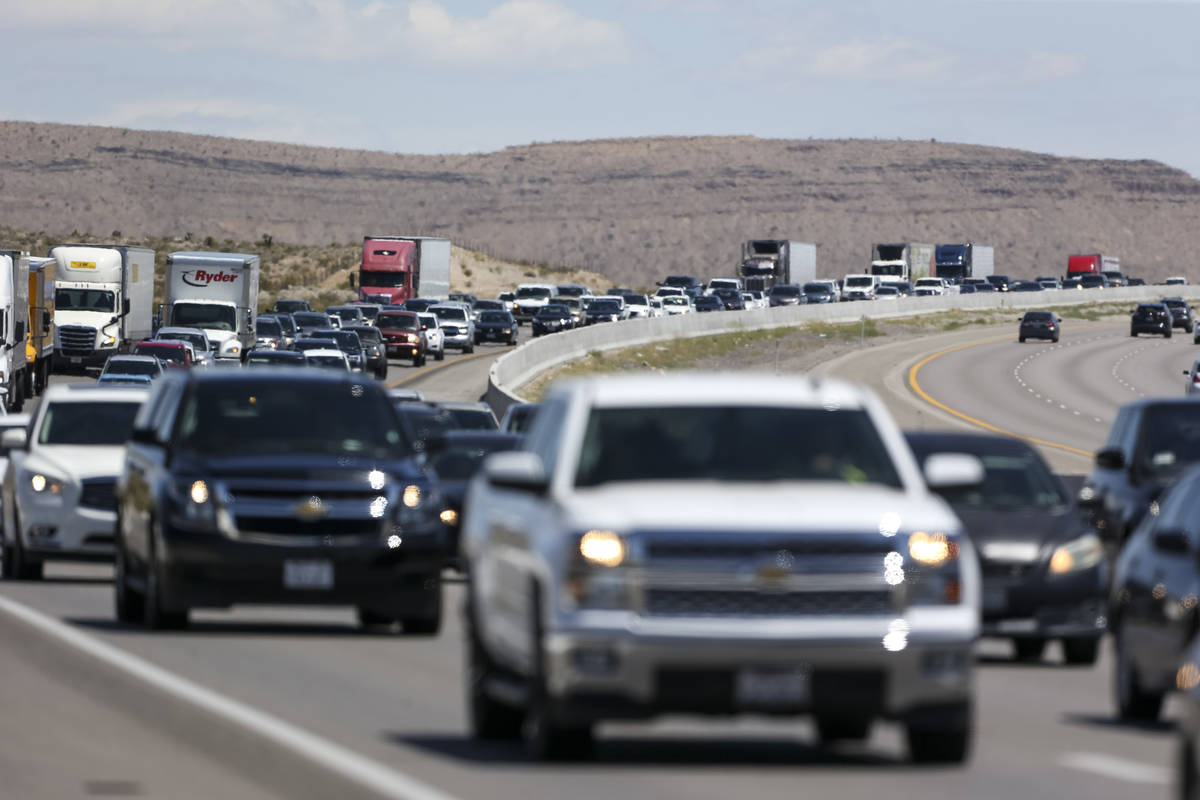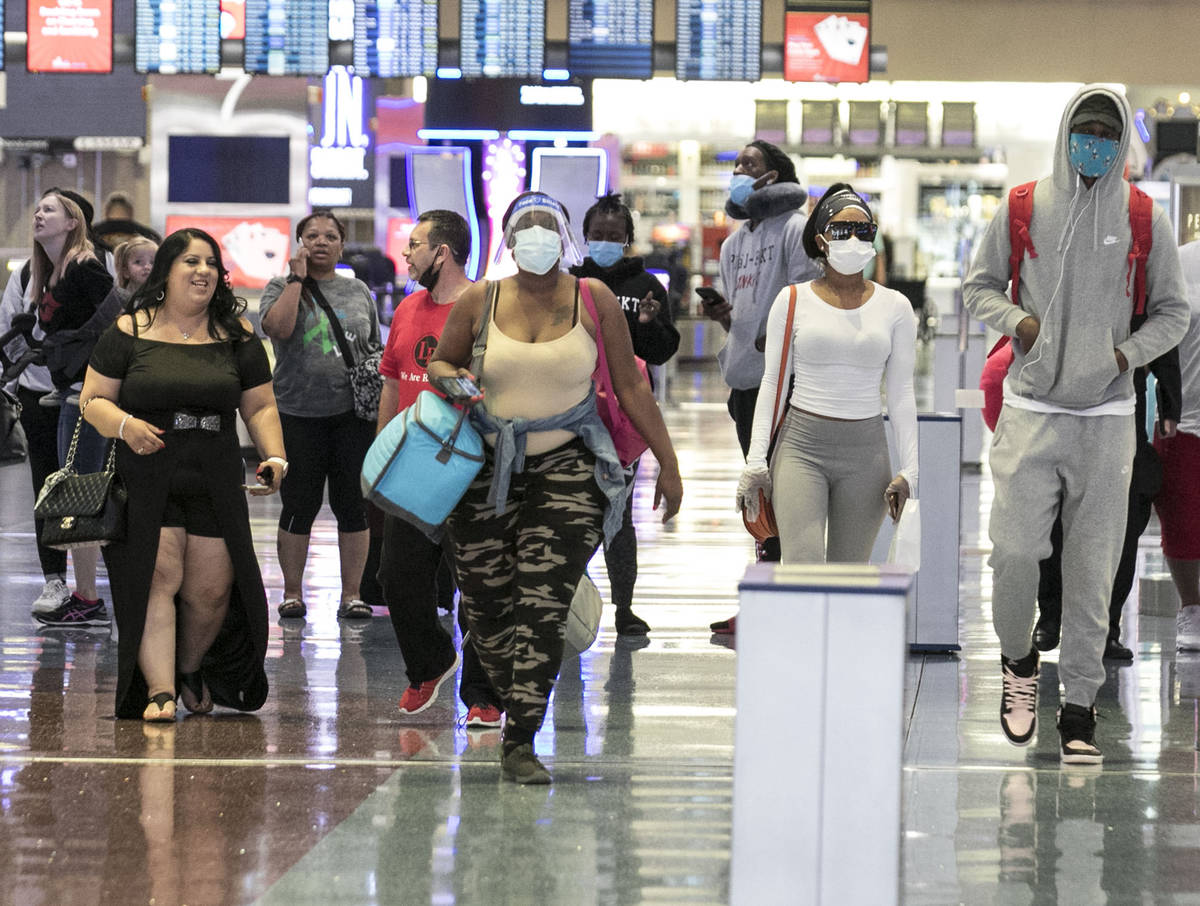Expect airport, roads to fill up as travel to Las Vegas returns
Las Vegas is slowly coming back to life following the reopening of select resort corridor properties.
In turn, McCarran International Airport will become increasingly busy, and roads, mainly Interstate 15 between Las Vegas and Southern California, will gradually see more traffic.
I-15 northbound at the Nevada-California line saw a 14 percent increase in traffic volume last Wednesday compared with Wednesday of the prior week and a 23 percent spike in traffic on reopening day, Thursday, compared with the previous Thursday, according to Brian Hoeft, director of the Regional Transportation Commission of Southern Nevada’s traffic management center.
On Friday, the I-15 northbound volume at Primm was up 37 percent over the previous Friday, but it was still 27 percent lower than the volume on the first Friday of June 2019.
The situation was much the same at McCarran. After the airport saw an average of 141 arriving flights per day in May, it saw over 190 arrivals on both Thursday and Friday, showing the slow ascent has begun.
During the statewide shutdown, McCarran was like a ghost town the times the Road Warrior visited, providing a stark contrast to how lively it usually is.
Seeing more passengers this week filling some areas of baggage claim, eager to get their luggage and head to the Strip, was great.
Who would’ve thought that seeing a traveler with a tall can of Modelo beer before 11 a.m. on a Thursday, waiting at the baggage carousel, would bring back a sense of normalcy?
As casino properties win back consumers and show that their safety protocols work, more and more resorts will reopen.
After an more than two-month shutdown, it’s time to bring the party back to Sin City — a socially distant and sanitized version, of course.
TSA policies
Those who haven’t flown since the pandemic began will need to prepare for new regulations at airport security checkpoints.
The Transportation Security Administration will implement the new policies later this month, as passenger volumes are expected to rise.
“In the interest of TSA front-line workers and traveler health, TSA is committed to making prudent changes to our screening processes to limit physical contact and increase physical distance as much as possible,” TSA Administrator David Pekoske said. “We continue to evaluate our security measures with an eye toward making smart, timely decisions benefiting health and safety, as well as the traveler experience.”
As procedure changes begin to roll out in the coming weeks, travelers should be ready to do the following:
Keep possession of their boarding passes: Travelers no longer will hand their boarding pass to a TSA officer at the podium. Instead, passengers should place their boarding pass — paper or electronic — on the boarding pass reader themselves. The change decreases the TSA officer’s need to touch a passenger’s boarding pass, reducing potential for cross-contamination.
Separate food for X-ray screening: Passengers are asked to place their carry-on food items into a clear plastic bag and place that bag in a bin. Food items can trigger an alarm during the screening process, and separating the food from the carry-on bag decreases the likelihood that a TSA officer will need to open the carry-on bag and remove the food items for inspection. TSA Precheck members will not need to remove items from their bags.
Pack smart: Passengers should ensure they don’t have any prohibited items, such as liquids, gels or aerosols in quantities greater than 3.4 ounces in their carry-on bags. In response to COVID-19, TSA allows one liquid hand sanitizer container up to 12 ounces per passenger in carry-on bags. Passengers are required to remove the hand sanitizer from the carry-on bag before being screened. If a bag is found to contain a prohibited item, passengers may be directed to return to the divestiture table outside of security with their carry-on bags to dispose of the item. By limiting setting off alarms, TSA officers won’t need to touch the contents inside a carry-on bag, reducing the potential for cross-contamination.
Practice social distancing: Passengers should social distance (at least 6 feet of separation) to reduce direct contact between employees and travelers whenever possible without compromising security.
Wear face protection. TSA officers at checkpoints wear face coverings, and travelers are encouraged to wear face protection too. Passengers might be asked to adjust their mask during the screening process.
Send questions and comments to roadwarrior@reviewjournal.com. Please include your phone number. Contact Mick Akers at makers@reviewjournal.com or 702-387-2920. Follow @mickakers on Twitter.












































